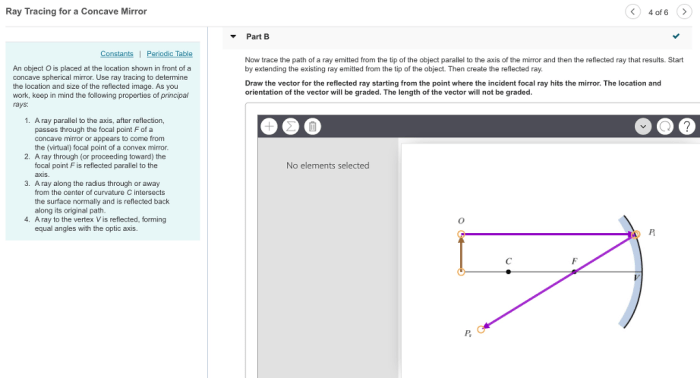The ray tracing mirrors gizmo answer key empowers computer graphics professionals with the ability to accurately model and visualize the behavior of light as it interacts with mirrors. This comprehensive guide delves into the intricacies of ray tracing, the role of mirrors in this process, and the invaluable insights provided by the Gizmo answer key.
Embark on a journey of discovery, unraveling the secrets of realistic mirror rendering and unlocking the potential of ray tracing technology.
Ray Tracing and Its Applications

Ray tracing is a computer graphics technique that simulates the path of light through a scene by tracing the individual rays of light as they interact with objects. This allows for realistic lighting effects, reflections, and shadows, creating images that are highly detailed and lifelike.
Ray tracing is widely used in industries such as film and video game development, architectural visualization, and product design. It enables the creation of visually stunning and immersive experiences, enhancing the realism and believability of digital content.
Mirrors in Ray Tracing
Mirrors play a crucial role in ray tracing as they reflect light and alter the direction of its path. When a ray of light strikes a mirror, it is reflected according to the law of reflection, which states that the angle of incidence (the angle between the incoming ray and the normal to the surface) is equal to the angle of reflection (the angle between the reflected ray and the normal).
There are different types of mirrors used in ray tracing, each with its own properties. These include flat mirrors, spherical mirrors, and parabolic mirrors. Flat mirrors reflect light in a straight line, while spherical mirrors and parabolic mirrors can focus or diverge light depending on their curvature.
Gizmo Answer Key
Gizmo is a software tool that provides interactive simulations and learning materials for science and mathematics. The Gizmo answer key is a resource that provides verified solutions to Gizmo simulations.
The Gizmo answer key can be used to verify the results of ray tracing simulations involving mirrors. By comparing the simulated results with the answer key, users can assess the accuracy of their ray tracing implementation and identify any potential errors.
However, it is important to note that the Gizmo answer key may have limitations and potential errors. It is always recommended to cross-check the results with other sources or analytical methods to ensure accuracy.
Troubleshooting Ray Tracing with Mirrors
When using mirrors in ray tracing, several common issues can arise, such as incorrect reflections, flickering, or artifacts. These issues can be caused by various factors, including numerical errors, incorrect mirror geometry, or improper handling of light interactions.
To troubleshoot these issues, it is important to check the following:
- Verify the accuracy of the mirror geometry and ensure that it is correctly positioned in the scene.
- Check for numerical errors or floating-point precision issues that may affect the calculation of light paths.
- Examine the lighting setup and ensure that the light sources are properly configured and do not intersect with the mirrors.
- Consider optimizing the ray tracing algorithm to reduce noise and artifacts, such as using adaptive sampling or denoising techniques.
Advanced Techniques in Ray Tracing with Mirrors, Ray tracing mirrors gizmo answer key
To enhance the accuracy and realism of mirrors in ray tracing, advanced techniques such as path tracing, global illumination, and subsurface scattering are often employed.
Path tracing is a Monte Carlo ray tracing algorithm that simulates the transport of light through a scene by randomly sampling light paths. This technique produces highly accurate and detailed images but can be computationally expensive.
Global illumination considers the indirect lighting effects that occur when light bounces multiple times within a scene. This technique creates more realistic lighting by simulating the interaction of light with surfaces and objects.
Subsurface scattering models the scattering of light beneath the surface of translucent materials, such as skin or marble. This technique adds depth and realism to materials by simulating the way light penetrates and interacts with the material’s interior.
Case Studies and Examples
Ray tracing with mirrors has been used in numerous real-world applications, including:
- Movie and video game development:Ray tracing has been used to create visually stunning and immersive environments in movies such as “Toy Story 4” and video games such as “Control.”
- Architectural visualization:Ray tracing is used to create realistic renderings of architectural designs, allowing architects and designers to visualize and evaluate their projects before construction.
- Product design:Ray tracing is used to create realistic product visualizations, enabling designers to showcase their products in a visually appealing and informative way.
FAQ Summary: Ray Tracing Mirrors Gizmo Answer Key
What is the significance of mirrors in ray tracing?
Mirrors play a crucial role in ray tracing by reflecting light rays and altering their paths. They introduce complexity and realism to virtual scenes, allowing for accurate simulations of light behavior in environments with reflective surfaces.
How does the Gizmo answer key assist in ray tracing?
The Gizmo answer key provides a set of reference solutions for ray tracing scenarios involving mirrors. It enables users to verify the accuracy of their ray tracing results, identify potential errors, and gain insights into the behavior of light under various conditions.
What are some common issues encountered when using mirrors in ray tracing?
Common issues include artifacts such as flickering, noise, and incorrect reflections. These can arise due to factors such as insufficient sampling, improper material properties, or numerical inaccuracies. Optimizing ray tracing algorithms and carefully configuring mirror parameters can help mitigate these issues.

